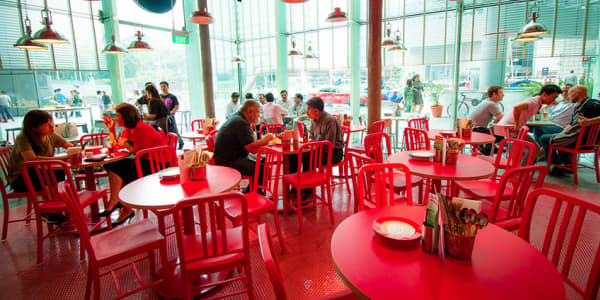From a 14th century fort in the desert to a colonial bungalow in the Himalayas, Aman Nath resurrected India's heritage to create a hotel chain that has wowed tourists over two decades.
"It's fun to sleep in, dream in and wake up in a monument and then eat home-made strawberry ice cream," Nath told CNBC.
An historian, author, copywriter and more famously the man behind the Neemrana "non-hotel" hotel chain in India, Nath has converted the country's architectural ruins, decrepit palaces and forts into profitable hotels.
The 64-year-old Nath spent his childhood doing homework at the 16th century garden tomb of the Mughal emperor Humayun in an historic precinct of Delhi.

His desire to enjoy old spaces has led Nath to build a portfolio of 28 heritage hotels across 10 Indian states, where its chic clientele get to experience India's history.
Turning liabilities into assets
Together with his friend, the late Francis Wacziarg, a French banker who became an Indian citizen, Nath started the "Neemrana movement" as the hotel industry often calls it, in the 1990s. They started by spotting the ruins of the Neemrana fort on the Delhi-Jaipur highway and decided to buy it.
Read MoreFor 2015, Asia hotels are your best holiday bargains
The fort was on the market for 40 years, with Jacqueline Kennedy Onassis, an Indian industrialist and an established hotelier among those who had once been interested in buying it. But none of them were "mad enough" to buy it and $11,000 (700,000 rupees) was paid for what could be called in 1986 a heap of rubble.
Today it is a 71-room iconic hotel property where the jet-set have their parties, conferences and weddings.
"Neemrana was a leap of innocence, enterprise is about not being scared," Nath said.
Keeping it real
The success of Neemrana hotels is linked to the vision of its founders who wanted to make India a real experience and not just raise the bar towards excessive luxury. Across properties, its 500 hotel staff are locally hired and trained with a purpose of instilling a sense of pride in their cuisine and culture. A conversation about a local tradition with the person who is serving you or eating a dish typical of that region is a far more real and memorable experience than having been to a cigar bar, feels Nath.
"Neemrana hotels" says a regular Indian guest "wows you with their sheer authenticity, there are no pretensions."
Nath says he never tried to strategize, always relied on his instincts and focused on what he would like himself. "I say to myself if there are fresh green peas growing in the field would I like to have that with a sprinkling of lime and freshly plucked coriander or open a can of asparagus? The answer is evident."
He adds, "Hotels are today made by executives using other people's money, imagining what rich people would want and keep escalating standards to five, six and seven star. We are not wooing luxury. Conspicuous luxury is in bad taste."
Hard to put a label
Neemrana hotels are not plush, but different and don't fit into any one category either luxury or mid-market, say industry experts.
Room rents vary hugely. You could pay as little as $39 (2,500 rupees) a night for a room in one of their properties in the Shekhavati region in the western Indian state of Rajasthan, while a room in the port city of Kochi can go up to $490 (31,200 rupees) a night during season time. Plus the average room rates at the flagship Neemrana Fort-Palace are higher than most 5 star hotels in Delhi.

Our room and food and beverage pricing is intuitive. We price rooms individually and never price it higher than what we would be comfortable paying for it," Sonavi Kaicker, CEO of Neemrana Hotels told CNBC.
She added that revenue has grown 25 percent year on year in the financial year ended March 31, 2015. "While we are committed to restoring Indian heritage and hiring locally, our properties have to be viable. We are a debt- free and profitable company," she said.
A privately held company that has "not borrowed a penny" or allowed any outside investment, Neemrana hotels' success is puzzling for some.
Uttam Dave, an expert who has been associated with the hotel industry for the past 30 years said, "It is hard to put a label on them, they have built a brand but are not a serious player in the hotel business, they haven't been driven by profit, the profits have been a result of a job well done."
Cashing in on well-heeled Indians
Just as Nath and Wacziarg were experimenting, taking a risk way back in the 90s, they were helped along by the liberalization of the Indian economy. India was now opening its doors to foreign investment and jobs that resulted in greater disposable incomes and international exposure for the country's middle class. This in turn had a positive impact on the hospitality sector.
Still in a nascent stage with just 1,13,000 rooms, the Indian hotel industry has the highest profitability rate – at 30-45 percent it is above the global average of 15-25 percent, according to hospitality consultancy firm HVS.
"Over the last 8 to 10 years the driver of growth for the hospitality sector has been the domestic tourist who is also high spending," Achin Khanna, managing director consulting and valuation, HVS South Asia, told CNBC.
While an increase in foreign arrivals, which is likely to touch 10 million in three years is likely to boost the heritage and luxury hotel segment, adds Khanna, the Indian traveler is going to be consuming most of the 45,000 new rooms which are expected to come online in the next 5 years.
"Indians have become richer, and why should they not enjoy their own heritage" said Nath. Neemrana hotels started at the right time when these well-heeled Indians were looking for places to splurge on, said experts. Today 75 percent of Neemrana hotels' guests are Indians compared to 40 percent in the early 1990s.
Now what does the future hold?
"People tell us to go abroad, no need…we have tobe through with India first," Nath, who continues to scoutfor ancient, charming properties and supervise their makeover,told CNBC, sitting in his tastefully done apartment in afashionable Delhi neighborhood.




